Punjab State Board PSEB 6th Class Science Book Solutions Chapter 8 Body Movements Textbook Exercise Questions and Answers.
PSEB Solutions for Class 6 Science Chapter 8 Body Movements
Science Guide for Class 6 PSEB Body Movements Intext Questions and Answers
Think and Answer (Textbook Page No. 77)
Question 1.
What are the small bones present in backbone called ?
Answer:
The small bones present in the backbone are called vertebrae.
Question 2.
Name the ridges like bones which we feel when we touch our chest region.
Answer:
Ribs are the ridges like bones which we feel when we touch our chest region.
![]()
Think and Answer (Textbook Page No. 78)
Question 1.
When you tie a scale with your arm, are you able to bend your elbow ?
Answer:
No, the tied parts are unable to move and we are unable to bend our elbow. From this we can conclude that we cannot bend a single bone. This means we can bend our body only at joints where the bones meet together.
Question 2.
Name the points where two parts of body are seen to be joined together.
Answer:
The points where two parts of body are joined together are called joints.
Think and Answer (Textbook Page No. 80)
Question 1.
Move your arm at shoulder. Are you able to move it in various directions ? If yes name the type of joint present there.
Answer:
Yes, I am able to move my arm in all directions. Ball and socket joint is present between the arm and the shoulder.
Question 2.
Move your arm at elbow. Are you able to move it in various directions ? If yes name the type of joint present there.
Answer:
No, at elbow, I am not able to move my arm in all directions. Arm can be moved back and forth only. The joint present here is hinge joint.
PSEB 6th Class Science Guide Body Movements Textbook Questions and Answers
Exercise – 1
1. Fill in the Blanks :
(a) The points where bones meet are called ……………..
Answer:
joints
(b) Human skeleton is made up of …………….. and cartilages.
Answer:
bones
(c) Skull protects …………….. of body.
Answer:
brain
(d) Earthworm can extend or shorten its body by using its ……………….
Answer:
muscles
(e) Knee joint is an example of …………. joint.
Answer:
hinge
![]()
2. Write True or False:
(a) Rib cage is conical structure made up of 12 pairs of ribs.
Answer:
True
(b) Cartilages are harder than bones.
Answer:
False
(c) Bones do not need the help of muscles to move.
Answer:
False
(d) A streamlined body is one in which middle part of body is larger than head and tail part.
Answer:
True
(e) Snakes move very fast in a straight line.
Answer:
False
3. Match the Column A with Column B:
| Column A | Column B |
| 1. Ball and Socket Joint | (a) Skull bones |
| 2. Immoveable Joint | (b) Fingers |
| 3. Hinge joint | (c) Wrist bones |
| 4. Pivot Joint | (d) Shoulder |
| 5. Gliding Joint | (e) Movement of Head |
Answer:
| Column A | Column B |
| 1. Ball and Socket Joint | (d) Shoulder |
| 2. Immoveable Joint | (a) Skull bones |
| 3. Hinge joint | (b) Fingers |
| 4. Pivot Joint | (e) Movement of Head |
| 5. Gliding Joint | (c) Wrist bones |
4. Choose the Correct Answer:
Question (i)
Which of the following organ is protected by rib cage ?
(a) Heart
(b) Brain
(c) Eyes
(d) Ear.
Answer:
(a) Heart
![]()
Question (ii)
Snail moves with the help of :
(a) Shell
(b) Bones
(c) Muscular foot
(d) Cartilage
Answer:
(c) Muscular foot
Question (iii)
Fish maintains its balance in water and change its directions with the help of
(a) Head
(b) Gills
(c) Fins
(d) Body scales.
Answer:
(c) Fins.
Exercise – 2
5. Very Short Answer Type Questions:
Question (i)
Name the longest bone in human body.
Answer:
Femur is the longest bone in the human body.
Question (ii)
Name the type of joint where arms join the shoulder.
Answer:
Ball and socket joint.
Question (iii)
What is the difference between movement and locomotion ?
Answer:
Movement is a change in the position of any part of body of an organism whereas locomotion is movement of whole body of an organism from one place to another.
Question (iv)
Give an example of an organism which can walk, climb and fly.
Answer:
Cockroach.
6. Short Answer Type Questions:
Question (i)
Why we need a pair of muscles to move a bone ?
Answer:
The contraction and relaxation property of the muscles is the basis of movement of bones. Muscles always work in pairs. When one them contracts it pulls the bone in that direction in which it is bulged. The other muscle relaxes. Now to bring back the bone to the original position the relaxing muscle contracts and the contracting muscle relaxes.
Question (ii)
How does earthworm move ?
Answer:
The body of the earthworm is made up of many rings joined together. These rings are connected with the muscles which help to extend or shorten the body.
During movement the earthworm extends the front part of the body while its rear portion is fixed to the ground. Then it fixes the front part and releases the rear part. Then it shortens its bpdy and repeats the whole process. The body secretions of earthworm help in its movement.
![]()
Question (iii)
How does the body of a bird help it in flight ?
Answer:
Birds possess streamlined body, and hollow and light weight bones which help them during flight. The birds can fly because their streamlined bodies are well suited from flying. The hollow bones are lighter and the breast bones are modified to hold massive muscles of flight which are used to move the wings up and down. The birds have tails which direction during flight.
7. Long Answer Type Questions:
Question (i)
Explain different types of joints present in human body.
Answer:
Joint. A point where two bones meet is called a joint.
Joints are of two types :
(1) Fixed Joints or Immovable joints. The joints where the movement of the bones is not possible are called fixed or immovable joints. For example, upper jaw has fixed joint. The joints in the skull are fixed joints.
(2) Moveable joints. The joints where movement of the bones is possible are called moveable joints.
These are of four types
(a) Ball and Socket Joint. In this joint, a ball like rounded end of one bone fits into socket like cavity of the other bone. This joint allows the movement of the bones in all the directions. Joint between arm and shoulder is an example of this type of joint.
(b) Pivot Joint. In this type of joint, a cylinderical bone turns in a ring type bone. The cylinderical bone rotates inside the ring or the ring rotates outside the cylinder. The joint between skull and the vertebral column is an example of pivot joint. It allows the movement of head backward, forward, left and right.
(c) Hinge Joint. This joint is like hinge in the door. It allows movement of bones only in one direction i.e. up and down or front and back. Knee joint and elbow joint are the examples of the hinge joints.
(d) Gliding joint. This joint allows the bones to glide over each other providing only a little movement in all the direction. The examples of gliding joints are the joints between the ankle bones and wrist bones.
Question (ii)
Explain the locomotion in Fish.
Answer:
Fishes possess streamlined body in which tail and head of fish are smaller than the middle part of the body. Fishes also have certain special structures called fins that help ih movement from one place to another. During swimming, the front part of the body curves into one side and tail part remains on the opposite side. Thus a loop is formed. Fishes produce regular jerks by making such loops and pushes the body forward. Fins help to maintain balance and change directions while swimming.
PSEB Solutions for Class 6 Science Body Movements Important Questions and Answers
Multiple Choice Questions:
Question 1.
Name the animal which slithers on the ground.
(a) earthworm
(b) snail
(c) lizard
(d) snake.
Answer:
(d) snake
Question 2.
Rotation of an arm is due to:
(a) Hinge Joint
(b) Pivotal Joint
(c) Ball and Socket Joint
(d) Fixed Joint.
Answer:
(c) Ball and Socket Joint
Question 3.
Skull is made up of:
(a) many bones
(b) one bone
(c) three bones
(d) none of the above.
Answer:
(a) many bones
Question 4.
Outer skeleton of snail is made up of:
(a) bones
(b) muscles
(c) none
(d) both.
Answer:
(b) muscles
Question 5.
A fish swims in the sea with help of :
(a) tail fin
(b) side fins
(c) muscles on the body
(d) All the above.
Answer:
(d) All the above.
![]()
Fill in the Blanks:
(a) We bend or rotate our body at ……………….
Answer:
Joints
(b) ……………… joint allows movements in all directions.
Answer:
Ball and Socket
(c) Elbow joint is an example of ……………….. joint.
Answer:
hinge
(d) X-rays help to know the ……………. of the bones.
Answer:
shape
(e) Backbone, chest bone and ribs form a cage called ………………..
Answer:
rib cage
(f) Backbone is made up of many ……………. bones.
Answer:
Small
(g) The part of our body below stomach is enclosed by ………………..
Answer:
pelvic bones
(h) Skull protects the ……………………
Answer:
brain
![]()
(i) Cartilages are found in the …………… of the body.
Answer:
joints
(j) The movement of bones is due to …………… and ……………… of muscles.
Answer:
contraction, relaxation
(k) The body of earthworm is made up of many ……………… joined end to end.
Answer:
rings
(l) Snails move with the help of ………………..
Answer:
muscular foot
(m) The ………………. muscles move the wings when a cockroach flies.
Answer:
breast
(n) Snake moves forward in ……………… not in a straight line.
Answer:
loops
Write (T) against true and (F) against false statements:
(a) A snake jumps on the earth.
Answer:
False
(b) The hard structure of our body is muscle.
Answer:
False
![]()
(c) Movement of body is due to cartilage in the body.
Answer:
False
(d) The pivot joint join head on the neck.
Answer:
True
(e) Bones in head are joined by movable joints.
Answer:
False
(f) Wrist is made of only single bone.
Answer:
False
(g) A long and hard structure at the back of body is back bone.
Answer:
True
(h) The upper part of ear has small bones in it.
Answer:
False
(i) Muscles work in pairs.
Answer:
True
(j) Fishes have a round body.
Answer:
False
Match the Column :
Match the items in Column A with items in Column B.
| Column A | Column B |
| (1) Bone of forearm | cranium |
| (2) Join bone to bone | ulna |
| (3) Join bone to muscles | tibia |
| (4) Bone of leg | ligament |
| (5) Brain case | tendon |
| (6) Teeth and gum | scales in the body |
| (7) Snake | chest cage |
| (8) Ribs | immovable Joint |
| (9) Snail | fly in the air. |
| (10) Cockroach | slow movement. |
Answer:
(1) Bone of forearm – ulna
(2) Join bone to bone – tendon
(3) Join bone to muscles – ligament
(4) Bone of leg – tibia
(5) Brain case – cranium
(6) Teeth and gum – cranium
(7) Snake – Scales in the body
(8) Ribs – chest cage
(9) Snail – slow movement
(10) Cockroac – fly in the air.
![]()
Very Short Answer Type Questions
Question 1.
How do plants move ?
Answer:
They sway with wind.
Question 2.
Name some movement of animals.
Answer:
Walk, Run, Fly, Jump, Creep, Crawl etc.
Question 3.
Which parts of human body move in one direction only ?
Answer:
Arm at elbow, leg at knee, Finger inside.
Question 4.
Can we move head to all sides ?
Answer:
No.
Question 5.
Which joint allow movement in all directions ?
Answer:
Ball and Socket joint.
Question 6.
By which joint neck and head are joined ?
Answer:
Pivotal Joint.
Question 7.
What is framework of body known as ?
Answer:
Skeleton.
Question 8.
The bone present at the back of body is made up of many small bones. What is its name ?
Answer:
Backbone.
![]()
Question 9.
Is there any bone in our ear ?
Answer:
No.
Question 10.
Name the book written by philosopher Aristotle ?
Answer:
Gait of Animals.
Question 11.
What are vertebrae ?
Answer:
Vertebrae. Vertebrae are small ring shaped bones.
Question 12.
What are floating ribs ?
Answer:
Floating Ribs : The last two pairs of ribs are free called floating ribs because they are attached to bone on one side only.
Question 13.
What is cell ?
Answer:
Cell. It is the smallest and functional unit of life.
Question 14.
What are tissues ?
Answer:
Tissue. A group of similar cells with same kind of function is called a tissue.
Question 15.
What are organs ?
Answer:
Organs. Various cells and tissues combine to form organs which do important body activities. Example : heart, lungs, stomach etc.
Question 16.
What is organ system ?
Answer:
Organ System. Several organs group together as a team to carry out major activities in the body called organ system.
For example : Digestive system comprises organs like mouth, food pipe, stomach, intestine, anus.
![]()
Question 17.
How bones differ from cartilages ?
Answer:
The hardest part of our skeleton is made up of bones while cartilages are comparatively soft and elastic.
Question 18.
What do you mean by a joint ?
Answer:
Joint. A place where two or more bones meet together is called a joint.
Question 19.
What are ligaments ?
Answer:
Ligament : Bones are held together at joints by strong cords called ligaments.
Question 20.
What are dislocations ?
Answer:
Dislocation : The bones at the joints dislodged from their normal position are called dislocations.
Question 21.
What are tendons ?
Answer:
Tendons. Muscles are attached to bones by tough cords called tendons.
Question 22.
Name the minerals used to make bones hard and strong.
Answer:
Calcium and phosphorus make the bones hard and strong.
Question 23.
Name the animals which do not have hard structure.
Answer:
The Jelly fishes, Leeches and worms have no hard structure to support their bodies.
![]()
Question 24.
Where do the following animals live
(i) Whale
(ii) Elephant
(iii) Frog
(iv) Fish.
Answer:
(i) Whale-In sea water
(ii) Elephant : Forest .
(iii) Frog : In water and on land.
(iv) Fish : River, pond, lake, sea.
Question 25.
Name the various parts of skeletal system.
Answer:
The skeletal system can be divided into following main parts :
- Skull
- Backbone
- Limb bones
- Chest bones
- Shoulder bones
- Hip bones.
Question 26.
Name the organs of locomotion of :
(i) Man
(ii) Birds
(iii) Fish.
Answer:
(i) Man : Legs
(ii) Birds : Wings
(iii) Fish : Fins.
Question 27.
How are bones joined together ?
Answer:
Bones are held together at joints by strong cords called ligaments.
Question 28.
How do fish move ?
Answer:
Fish move with the help of its tail and fins.
Short Answer Type Questions
Question 1.
What is Ball and Socket Joint ? Give example.
Answer:
Ball and Socket Joint : In this joint, round end of one bone fits into the hollow space of other bone, thus allowing movement in all directions. Example : The joint between upper arm and the shoulder.
Question 2.
Write a short note on rib cage.
Answer:
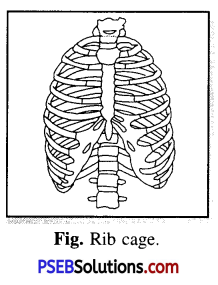
Rib cage. In the upper part of body, there is a cage of bones. The chest bone, back bone and ribs join together to form a box called ribcage. It encloses the soft and important organs of the body.
Question 3.
Draw a neat diagram of Pelvic bones.
Answer:
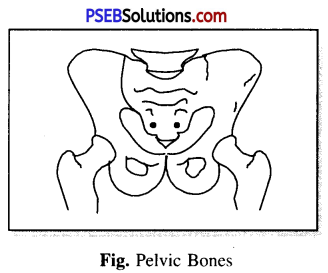
Question 4.
Which other parts are found in skeleton besides bones ?
Answer:
Besides bones, cartilage, tendon are other parts of our skeleton.
![]()
Question 5.
What are the functions of back bone ?
Answer:
Functions of back bone :
- It supports the body.
- It helps in erect posture of body.
- It helps in forming rib cage.
- It provides protection to spinal cord.
- It helps in bending of the body.
- It helps in neck movements.
Question 6.
Why do animals move ?
Answer:
Animals move from one place to another in search of food. They also move to escape from their enemies.
Question 7.
Which movements are shown by a cockroach ? Which parts help in these movements.
Answer:
Movement of Cockroach. Cockroaches can walk, climb and fly in the air. Three pairs of legs help cockroaches in walking. Two pairs of wings attached to breasts help in flying.
Question 8.
How does a snake move ?
Answer:
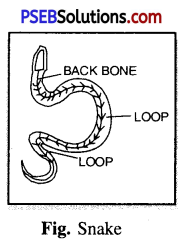
Movement of Snake. The snake curves its body into its many loops. Each loop gives a forward push by pressing against the ground. The number of loops help in quick movement of the snake.
Its movements are not in the straight line.
Question 9.
What is Skeletal System ?
Answer:
Skeletal System. The skeletal system is made up of many pieces of bones and cartilages. The bone is hard. Cartilages are comparatively soft and elastic. Both gives shape and structure to the body. It protects internal organs. It keeps the body erect and helps in movement of the body.
Question 10.
How many bones are there in human baby and human adult ?
Answer:
A human baby is bom with about 300 bones. Some of these gradually become inseparably united or fused and a human adult has 206 bones.
Question 11.
Name the parts of axial skeleton.
Answer:
It consists of bones of skull, vertebral column and chest
![]()
Question 12.
Write few lines on human skull. Also draw it.
Answer:
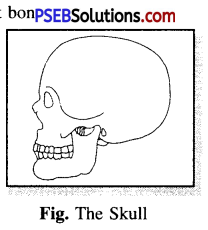
Human Skull. Human skull is made of many bones joined together. It encloses and protects a very important part of the body, the brain. The facial bones comprises the upper and lower jaw. The lower jaw is movable.
Fig. The Skull
Question 13.
What is backbone and also draw it ?
Answer:

Backbone. The backbone extends from the base of the skull to the hip. It is made of 33 small bones called vertebrae. The rib cage is joined to these bones. The backbone , and strong back muscles help us to stand erect.
Question 14.
What are shoulder bones ? Which body part is attached with it ?
Answer:
Shoulder bones. The shoulder bone is formed by the collar bone and shoulder blade. It connects the upper part of the chest and bones of the hand. The bone of the upper arm attaches with the shoulder bones.
Question 15.
What is pelvis ? Which bones of the body are attached with it ?
Answer:
Pelvis. The hip bone is formed by the fusion of three bones. The hip bones together with the last two parts of backbone form a large bony bowel. It is called the Pelvis. It is the lowest and strongest part on which we sit. The thigh bones are attached to the hip bones.
Question 16.
Write about the bones of fore limb.
Answer:
Bones of fore limb. Fore limb includes Lie bones of upper arm, fore-arm, wrist, palm and fingers. Our palm consists of many small bones.
Question 17.
Give some examples of fixed and hinge joints.
Answer:
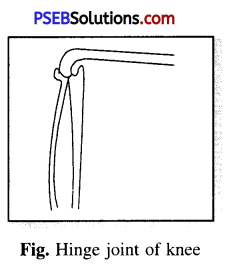
(i) The elbow has a hinge joint that allows only a back and forth movement. Our knee also has hinge joint.
(ii) Upper jaw and rest part of the head has a fixed joint.
![]()
Question 18.
What is pelvic and pectoral girdle ?
Answer:
Girdles are attached to the axial skeleton system and in turn gives support to the bones of the limbs.
Pectoral girdle. The girdle that supports the bones of arm is called pectoral girdle. It consists of two pairs of shoulder bones.
Pelvic girdle. The girdle into which the bones of legs are fitted, is called the pelvic girdle.
Question 19.
What do you mean by bone joints. Name two basic types of joints ?
Answer:
Joint. The place where two or more bones meet together is called a joint. Bones are held together at joints by strong cords called ligaments.
There are basically two types of joints :
- Fixed or immovable joint
- Movable joints.
Question 20.
What is dislocation and fracture ? What are its causes ?
Answer:
Dislocation. Any sudden movement – a jump, fall may cause an injury to the skeleton and dislocation occurs. In dislocation the bones at the joints are dislodged from their normal position. The ligaments may be tom apart or injured causing pain and swelling. A fracture is a case when bone breaks into one or many pieces.
Question 21.
Name the various organs where cartilages are found.
Answer:
Nose, Ear and various joints.
Question 22.
Write down the functions of skeleton.
Answer:
Functions of skeleton :
- It supports the body and gives definite shape to it.
- It helps to protect delicate and vital organs like heart, lungs and brain.
- It helps in the movement of body parts.
- It is a store of minerals and is the place for the formation of RBC cells.
Question 23.
Write down the functions of pectoral girdle.
Answer:
Functions of pectoral girdle
- Provides support to the interior parts of the body.
- Provides surface for articulation of forearms.
- Provides surface for the attachment of muscles.
- Provides protection to the vital organs like heart and lungs.
Question 24.
Write down the functions of pelvic girdle.
Answer:
Functions of pelvic girdle
- Provides surface for articulation of hindlimbs.
- Provides surface for joining of muscles.
- Provides protection to the uterus.
- Protects from shocks.
![]()
Question 25.
How do animals move ?
Answer:
There are two kinds of animal movements :
(i) In one kind of movement, the organisms move their body parts without changing their position. Example : sponges, corals and sea anemone show this kind of movements.
(ii) In other kind of movement, the animals move from place to place. This kind of movement is called locomotion. It helps the animal to escape from their enemies as well as helps them to search food.
Question 26.
How do birds fly ?
Answer:
The birds can fly because their bodies are well suited for flying. The body is streamlined. The bones have air spaces to make them strong and light. The bony parts of the forelimbs are modified as wings. The breast muscles are modified to hold massive muscles of flight which are used to move the wings up and down .
Question 27.
How do fish move about ?
Answer:
Fish has certain special structures called fins that help in its movement from one place to another. During swimming, the front part of the body curves in one side and tail part remains in the opposite side.
It forms a loop. This makes a jerk and pushes the body forward. A series of such jerks make the fish swim ahead.
Question 28.
How does a snail move ?
Answer:
Snails move slowly with the help of a flat foot. The foot glides with the help of muscles. The foot is present under the belly. So, it looks as if it is moving on its belly. The movement of snail is very slow.
Long Answer Type Questions
Question 1.
How do muscles help in movement of bones ?
Answer:
Muscles on contraction become smaller in length and bulge outside. This contraction and relaxation property of muscles is the basis of movement of bones.
Muscles work in pair. When one of them contracts, it pulls the bone in that direction in which it is bulged. The other muscle relaxes. Now to bring back the bone to original position, the relaxing muscles contracts and contracting muscle relaxes. In this way the bones move.
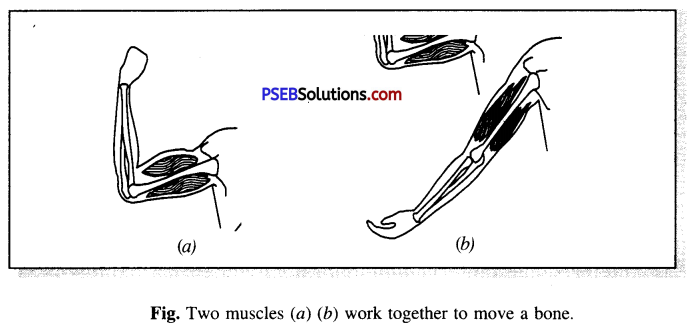
Question 2.
What are joints ? Name different types of joints. Explain any two of them.
Answer:
Joint. A place where two bones meet is called joint.
The joints are held together by stong tissues called ligaments. Joints may be movable or immovable (fixed) in a body. Different movable joints in the body are :
- Hinge joint
- Ball and Socket joint
- Pivot joint
- Gliding joint.
Fixed joints (Immovable). The attachements in which bones do not allow movements is a fixed joint e.g. Bones of skull are attached with fixed joints.
Ball and Socket joint. In this attachment the round end of one bone fits into the hollow space of other bone. This joint allows movement in all directions e.g. arm and leg joints.
Question 3.
Explain movement in earthworms.
Answer:
Movement in earthworm:
The body of an earthworm is made up of many rings joined together. These rings are connected with muscles that help to extend or shorten the body.
During movement, the earthworm extends the front part of the body while its rear portion is fixed to the ground. Then it fixes the front part and releases the rear part. Then it shortens its body and repeats the whole process. A body’s secretion helps in its movements.